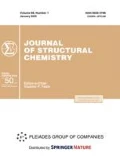Abstract
2-Chloro-1,3,2-dioxaphosphorinane-2-oxide, -sulfide, and -selenide are studied at the DFT/B3LYP level and several ab initio methods using a 6-311G** basis set. Our energy optimizations by all these methods show that for oxide DFT and ab initio methods are not much different, while for the sulfide and the selenide the DFT relative energies are higher by about a kcal/mol as compared to those of MP2, MP3, MP4(SDTQ)//MP2, and CCSD(T)//MP2 (//MP2 indicates that a single-point calculation based on the MP2 optimized geometry is performed). However, regardless of rather large relative energies, that does not change the fact that in all three cases the conformational equilibrium mixture contains more than 95% of the lowest, chair-equatorial conformer (this indicates that the P=X bond is in equatorial position). This one and the next higher conformer (chair-axial) are confirmed to be real conformers (energy minima) in all cases. The energetically much higher twist and boat forms are probably just stationary states and local maxima because in many cases, geometry optimizations do not converge to them. Only for MP2 and the selenide do all optimizations converge to the desired stationary state. The relative energies could all be explained in terms of anomeric effects and ring strains. The decreasing covalent character of the P=X bond, with X changing from O to S and to Se, shows itself in the increasing bond lengths and the decreasing strength of anomeric effects.
Similar content being viewed by others
References
J. E. Katon and W. R. Jr. Feairheller, Spectrochim. Acta, 21A, 199 (1965).
G. Fini and B. Furtonato, Spectrochim. Acta, 32A, 423 (1976).
J. L. Alonso, J. Mol. Struct., 73, 71 (1981).
J. L. Alonso and D. G. Lister, J. Chem. Soc. Chem. Commun., 2, 93 (1982).
V. A. Naumov and V. N. Semashko, Zh. Strukt. Khim., 14, 595 (1971).
H. M. Badawi, W. Förner, B. El-Ali, and A. Al-Durais, Spectrochim. Acta, A, 70, No. 5, 983–990 (2008).
Y. Ashani, S. L. Snyder, and I. B. Irwin, Biochem., 11, 3518 (1972).
R. R. Shagidullin, I. K. Shakirov, K. Plyamovatyi, et al., Zh. Obsh. Khim., 46, 1021 (1976).
G. Amitai, Y. Ashani, Y. Grunfeld, et al., J. Med. Chem., 19, 810 (1976).
D. V. Prasad and V. Mahadevan, Polymer Bull., 3, 241 (1980).
N. M. Zaripov and R. M. Galiakberov, Zh. Strukt. Khim., 25, 143 (1984).
A. A. Hernandez-Laguna, C. I. Sainz-Diaz, Y. G. Smeyers, et al., J. Phys. Chem., 98, 1109 (1994).
S. Cserepi-Suucs, I. Toth, L. Parkanyi, and J. Bakos, Tetrahed. Asymm., 9, 3135 (1998).
C. D. Hager, A. E. Sopchik, and W. G. Bentrude, J. Org. Chem., 65, 2778 (2000).
Z. Luo and D. Shi, J. Heterocyc. Chem., 43, 1021 (2006).
H. M. Badawi, W. Förner, and A. A. Suwaiyan, J. Mol. Struct. (accepted.) (2008).
I. K. Shakirov and R. R. Shagidullin, Zh. Obsh. Khim., 48, 508 (1978).
R. R. Shagidullin, I. K. Shakirov, R. K. Musyakaeva, et al., Izv. Akad. Nauk SSSR, Ser. Khim., 7, 1535 (1981).
J. H. Billman, R. F. May, and J. E. Heard, J. Pharm. Sci., 57, 1809 (1968).
Hooker Chemical Corp., Patent GB 853798 19601109 (1960).
W. M. Lanham, Union Carbide Corp., Patent US 2892862 19590630 (1959).
W. M. Lanham, Union Carbide Corp., Patent US 2894016 19690707 (1969).
M. J. Frisch, G. W. Trucks, H. B. Schlegel, et al., Gaussian, Inc., Pittsburgh PA (1998).
Author information
Authors and Affiliations
Corresponding author
Additional information
Original Russian Text Copyright © 2011 by W. Förner and H. M. Badawi
The text was submitted by the authors in English. Zhurnal Strukturnoi Khimii, Vol. 52, No. 2, pp. 269–276, March–April, 2011.
Rights and permissions
About this article
Cite this article
Förner, W., Badawi, H.M. Anomeric effect and theoretical vibrational spectra compared to the experiment in 2-chloro-1,3,2-dioxaphosphorinane-2-oxide, -sulfide, and -selenide. I. Anomeric effect and structures. J Struct Chem 52, 257–264 (2011). https://doi.org/10.1134/S0022476611020041
Received:
Published:
Issue Date:
DOI: https://doi.org/10.1134/S0022476611020041




